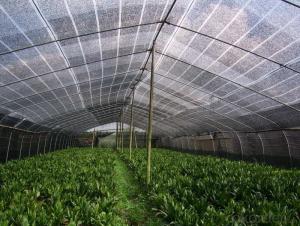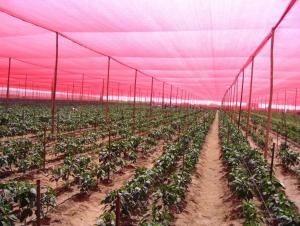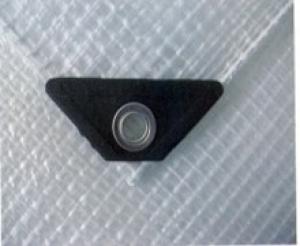Heavy Duty Plastic Garden Netting - Export Sun Shade Net for Vegetable and Fruit Cover
- Loading Port:
- Wenzhou
- Payment Terms:
- TT OR LC
- Min Order Qty:
- 50 m²
- Supply Capability:
- 20000 m²/month
OKorder Service Pledge
OKorder Financial Service
You Might Also Like
Export Sun Shade Net for Vegetable and Fruit Cover
Description:
100% Virgin HDPE sun shade net
2015 factory supply 30%--95%shade rate sun agriculture greenhouse shade cloth /mesh shade netting with competitive price
High Density Polyethylene Shade Net,Shade netting in plastic mesh is used against sun's harmful rays.We are always developing and searching for new technologies to improve the quality of your work and your profitability.
Charicteristics:
1.slows heat loss and keep the soil temperatures at night.
2.Shading meshes for solar protection of crops.
3.Restricting ultraviolet ray action on plants.
4.Reducing humidity loss in soil.
5.Enhances plant airing.
6.Protection against extreme temperatures.
7.increase crop yields
| Material | 100% virgin HDPE + 3% UV |
| Shade rate | 30%--90% |
| Net weight | 50G-200G/M2 or as you request |
| Life Usage | At least 5 years |
| Length | 50m,100m or as you request |
| Width | 2m,4m or as you request |
| Wire | Round or flat wire |
| Terms of payment | T/T, L/C 30% for advance and 70% for balance ,100% L/C at sight |
| Delivery time | 25-35 days after deposite |
| Packing | Rolls on cardboard tubes & wrapped in plastic with color label (or any customized) |
Product show:






Packing: Each roll packed in one strong transparent pe cloth and one paper tube in it.

Application of green sun shade net :
The netting is ideal for Green Houses, Aviaries, Protecting Livestock, Indoor Plant and for Fruit and Vegetable shade covering, Courtyards, Scaffolding and Construction
Agricultural: provide shade against sunlight,frost,wind and hail damage and to control temperature, realization of high yield, high quality agricultural cultivation technology.
Horticultural: can be used for flowers ,fruit trees in greenhouse or greenhouse covering or outdoors.
Animals feeding and protect : can used for temporary fencing feed lots,chincken farms,etc.or protect plant against wild
animals.
Public areas: provide a temporary fencing for children's playgroud ,as a shade sail parking lots, swimming pools, beaches etc.


Certification:

FAQ:
1. How can i get the sample?
Free sample is available.
2. Can we use our own shipping agent?
Yes, you can. We had cooperation with many forwarders. If you need, we can recommend some forwarders to you and you can compare the prices and service.
- Q: How do you transport plastic nets safely?
- Plastic nets can be transported safely by ensuring they are properly secured and protected during transit. This can be done by using appropriate packaging materials such as sturdy boxes or pallets, and using straps or stretch wrap to tightly secure the nets in place. Additionally, it is important to handle the nets with care to avoid any damage or tearing.
- Q: How do plastic nets help in preventing seed dispersal?
- Plastic nets help in preventing seed dispersal by creating a physical barrier that traps the seeds within a designated area. These nets are often used in agriculture and gardening to control the spread of seeds, ensuring that they stay in a specific location and do not disperse to unwanted areas.
- Q: Can plastic nets be used for fruit tree protection?
- Yes, plastic nets can be used for fruit tree protection. These nets are often used to prevent birds and pests from accessing and damaging the fruit on the tree. The nets create a physical barrier that keeps the fruit safe while still allowing sunlight and air circulation.
- Q: Can plastic nets be used for boundary marking?
- Yes, plastic nets can be used for boundary marking. They are lightweight, durable, and often come in bright colors that make them highly visible. Plastic nets can be easily stretched or tied between posts to clearly define boundaries, whether it's for sports fields, construction sites, or other applications.
- Q: Are plastic nets reusable?
- Yes, plastic nets can be reusable.
- Q: How do plastic nets affect the durability of products?
- Plastic nets can significantly enhance the durability of products by providing structural support and reinforcing their strength. The netting acts as a protective layer, distributing stress and preventing the product from breaking or wearing out easily. This increased durability ensures that the product can withstand various external forces and extends its lifespan, making it more reliable and cost-effective.
- Q: How do plastic nets help in preventing soil erosion on slopes?
- Plastic nets help in preventing soil erosion on slopes by acting as a physical barrier that holds the soil in place. The nets are installed horizontally across the slope, and their open mesh structure allows water to pass through while preventing the soil particles from being washed away. This helps in stabilizing the soil and promoting vegetation growth, as it provides a protected environment for plant roots to establish. Additionally, the nets also help in reducing the impact of wind on the slope, further preventing erosion.
- Q: How do plastic nets provide protection against theft?
- Plastic nets provide protection against theft by acting as a physical barrier that prevents unauthorized access to valuable items or areas. These nets are often used in retail stores or construction sites to secure merchandise or equipment, making it difficult for thieves to snatch or tamper with the items. Additionally, plastic nets can be easily installed and are cost-effective compared to other security measures, making them a popular choice for theft prevention.
- Q: How durable are plastic nets?
- Plastic nets are highly durable and able to withstand various environmental conditions, making them ideal for long-term use.
- Q: Are plastic nets suitable for use in poultry hatcheries?
- No, plastic nets are not suitable for use in poultry hatcheries.
Send your message to us
Heavy Duty Plastic Garden Netting - Export Sun Shade Net for Vegetable and Fruit Cover
- Loading Port:
- Wenzhou
- Payment Terms:
- TT OR LC
- Min Order Qty:
- 50 m²
- Supply Capability:
- 20000 m²/month
OKorder Service Pledge
OKorder Financial Service
Similar products
Hot products
Hot Searches
Related keywords

































